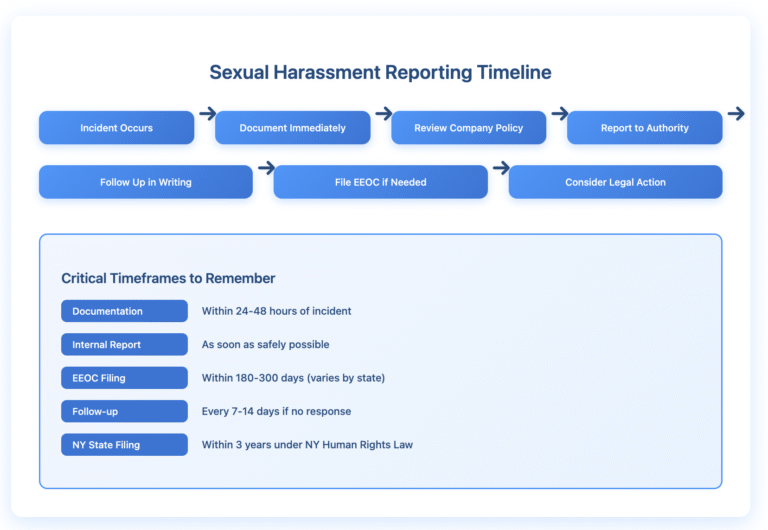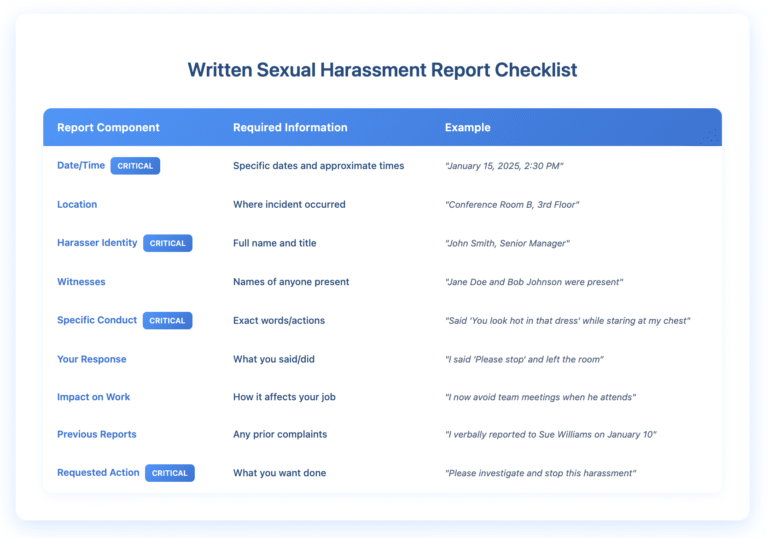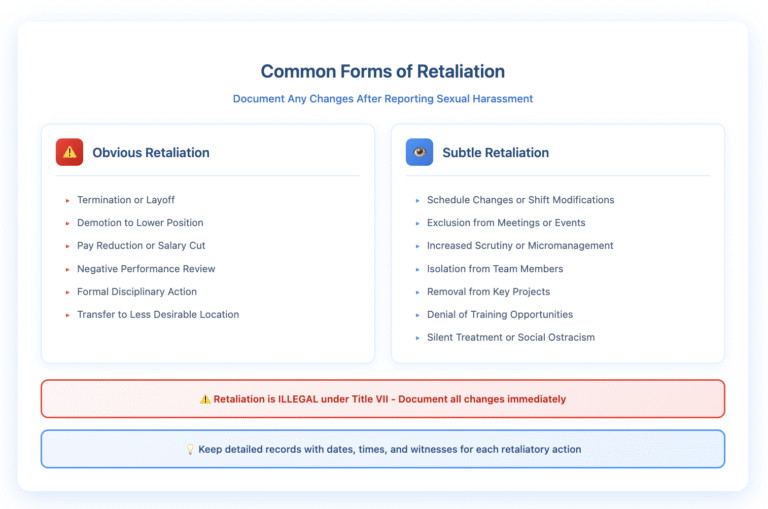If you’re experiencing sexual harassment at work, knowing how to report it properly can make the difference between getting justice and having your complaint dismissed. This guide walks you through exactly what to do, when to do it, and how to protect yourself throughout the process.
You’ll learn the specific documentation you need, who to report to, and how to create an undeniable paper trail that protects your rights. Most importantly, you’ll understand how to navigate this difficult situation while safeguarding your career and well-being.
Disclaimer: This article provides general information for informational purposes only and should not be considered a substitute for legal advice. It is essential to consult with an experienced employment lawyer at our law firm to discuss the specific facts of your case and understand your legal rights and options. This information does not create an attorney-client relationship.
Understanding Your Reporting Obligations
Before diving into the reporting process, you need to know that federal law doesn’t technically require you to report harassment to your employer before filing an EEOC complaint. However, the Supreme Court’s decisions in Burlington Industries v. Ellerth and Faragher v. City of Boca Raton created what’s known as the Faragher-Ellerth defense.
This defense allows employers to avoid liability if they can prove they had proper anti-harassment policies in place and you unreasonably failed to use them. That’s why reporting through proper channels becomes crucial for your case.

Who to Report To: Following the Chain of Command
Your employee handbook likely outlines specific reporting procedures, but if it doesn’t, or if your harasser is in that chain of command, you have options. Start by identifying the appropriate person or department to receive your complaint.
Typically, reports should go to your immediate supervisor, HR department, or a designated EEO officer. If your harasser is your supervisor, skip them and go directly to their boss or HR.
When Your Harasser Controls the Reporting Chain
This situation requires strategic thinking. Document your attempts to report through normal channels and explain why those channels weren’t available. Courts recognize that reporting to your harasser would be futile and don’t require it.
Send your complaint to multiple recipients simultaneously – HR, upper management, and any compliance hotline your company maintains. This creates multiple witnesses to your report and prevents anyone from claiming ignorance.
Creating Your Written Report
Verbal complaints can disappear into thin air. Always follow up any verbal report with a written complaint, even if it’s just an email saying “This confirms our conversation today about…”
Your written report needs specific elements to be effective. Include dates, times, locations, and witnesses for each incident. Describe the conduct objectively – what was said or done, not how it made you feel initially.
Essential Elements of Your Written Complaint
Start with the most recent incident and work backward chronologically. Use clear, factual language: “On January 15, 2025, at approximately 2:30 PM in the break room, John Smith placed his hand on my lower back and said…”
After describing the incidents, explicitly state that you believe this constitutes sexual harassment and request that the company investigate and take appropriate action. Keep a copy of everything you submit.

Documentation Strategies That Strengthen Your Case
Contemporary documentation beats reconstructed memories every time. Start a harassment journal immediately, even if you’re not sure you’ll report yet. Email yourself after each incident with details while they’re fresh.
Save all electronic evidence – texts, emails, chat messages, or social media posts. Take screenshots and forward them to a personal email account you control. If your harasser leaves voicemails, record them with another device and transcribe them.
The Power of Contemporaneous Notes
Courts give significant weight to notes made at or near the time of events. Your documentation should answer the journalist’s questions: who, what, when, where, why, and how.
Include seemingly minor details that establish credibility – weather conditions, what people wore, or ongoing office events. These details make your account more believable and harder to dismiss as fabricated.
Following Company Procedures While Protecting Yourself
Most employers have specific harassment reporting procedures outlined in employee handbooks or policy manuals. Follow these procedures exactly as written, but don’t stop there.
If your company requires you to report to HR first, do so – but also send a copy to someone in upper management. This prevents HR from burying your complaint or handling it inadequately.
When Company Procedures Fail
If you’ve reported and nothing changes within two weeks, escalate. Send a follow-up noting the lack of response and copying additional managers. The law recognizes that one report should be enough, but persistent harassment after reporting strengthens your case significantly.
Document your employer’s response or lack thereof. If they investigate, cooperate fully but keep your own records of what you’re asked and what you share.
Understanding Retaliation Protection
Title VII makes it illegal for employers to retaliate against you for reporting sexual harassment. Retaliation can include termination, demotion, schedule changes, or any action that would discourage a reasonable person from reporting.
The EEOC actually receives more retaliation charges than any other type of discrimination claim. Document any changes in how you’re treated after reporting – even subtle ones like being excluded from meetings or receiving worse assignments.

External Reporting Options
While internal reporting is important for preserving your legal claims, you’re not limited to company channels. The EEOC accepts charges of discrimination, and many states have their own civil rights agencies with longer filing deadlines.
You have 180 days from the last incident to file with the EEOC, extended to 300 days in states with their own fair employment agencies. New York, for instance, gives you three years under state law.
When to File with the EEOC
Consider filing an EEOC charge if your employer doesn’t respond to your internal complaint within 30 days, the harassment continues after reporting, or you experience retaliation. You don’t need an attorney to file, though having one can strengthen your position.
The EEOC will investigate and might attempt mediation. Even if they don’t find cause, you’ll receive a right-to-sue letter that allows you to file a lawsuit.
Building Your Support Network
Reporting sexual harassment can be isolating. Identify allies in your workplace who can serve as witnesses or provide emotional support. Document who else has experienced similar treatment from the same harasser.
Consider joining employee resource groups or professional organizations that can provide guidance and support. Many industries have specific resources for addressing workplace harassment.
Witness Statements and Corroboration
Ask witnesses to provide written statements about what they observed. Even if they didn’t see the harassment directly, they might have noticed changes in your behavior or heard the harasser make inappropriate comments.
Corroboration doesn’t require eyewitnesses to every incident. Evidence that you told someone contemporaneously (at the time) about the harassment can be powerful supporting evidence.
Protecting Your Digital Evidence
Your work computer and email aren’t private. Forward important evidence to a personal account immediately. Use your personal phone to photograph documents if you can’t make copies.
Be strategic about what you put in writing at work. Assume anything on company systems could be deleted or used against you. When possible, conduct sensitive communications about your case from personal devices.
Creating Redundant Backups
Don’t rely on a single copy of anything. Email evidence to yourself, save it to cloud storage, and print hard copies. Store copies in multiple locations – some people even mail sealed copies to themselves to establish dates.
Screenshots should include full headers showing dates and times. For text messages, capture the entire conversation thread, not just individual messages.
Managing Workplace Dynamics During Investigation
Once you’ve reported, you’ll likely still need to work alongside your harasser during the investigation. Request interim measures like schedule changes or temporary reassignment if needed for your safety or well-being.
Document any attempts by the harasser or others to discuss the complaint with you. Politely decline to discuss ongoing investigations and report any pressure to HR and your attorney.
Professional Behavior During Investigations
Continue performing your job duties excellently. Harassers sometimes claim performance issues to justify their behavior or retaliate. Don’t give them ammunition.
Remain professional in all interactions. Avoid discussing the case with coworkers beyond the necessary witnesses. Social media posts about your situation could harm your case.
Understanding Investigation Timelines
Most competent investigations conclude within 30-60 days. If your employer drags their feet, document it. Unreasonable delays can be evidence of discrimination or indifference to harassment.
You have the right to know the outcome of the investigation, though employers aren’t required to share all details. If they claim no harassment occurred, request the basis for that conclusion in writing.
What Happens After An Investigation
If the investigation substantiates your complaint, the employer must take prompt corrective action. This might include disciplining the harasser, providing adequate prevention programs, or implementing new policies.
If you’re unsatisfied with the outcome, you still have external options. An employer’s internal finding doesn’t bind the EEOC or courts. Many successful lawsuits follow inadequate internal investigations.
Financial and Career Considerations
Reporting harassment shouldn’t derail your career, but it’s wise to prepare for various outcomes. Update your resume and begin networking discreetly. Document your performance reviews and achievements.
Consider whether you might need to leave your job for your well-being. If so, document how the harassment and your employer’s response forced you to quit. This could support a constructive discharge claim.
Negotiating Resolutions
Some cases resolve through negotiated settlements. These might include monetary compensation, neutral references, policy changes, or training requirements. Never sign anything without understanding what rights you’re waiving.
Severance agreements often include broad release clauses. New York law now limits non-disclosure provisions in harassment settlements, but you should still have an attorney review any agreement.
State-Specific Protections in New York
New York State Human Rights Law provides broader protections than federal law. There’s no minimum employee requirement – even small employers are covered. New York City’s law is even more protective.
New York doesn’t require severe or pervasive harassment – any harassment based on a protected characteristic that rises above “petty slights and trivial inconveniences” is illegal.
Recent Legal Developments
The 2019 amendments to New York’s Human Rights Law eliminated the Faragher-Ellerth defense for employers. Employers can’t escape liability just because you didn’t report according to their policy.
The statute of limitations for sexual harassment claims in New York is now three years. You also have longer to file administrative complaints – up to three years with the State Division of Human Rights.
Common Reporting Mistakes to Avoid
Don’t wait too long, hoping it will stop on its own. The longer you wait, the harder it becomes to explain why you didn’t report sooner. However, delayed reporting doesn’t destroy your case – many valid reasons exist for not reporting immediately.
Avoid using inflammatory language in your reports. Stick to facts rather than conclusions. Let investigators determine whether the conduct violates policy or law.
Maintaining Credibility
Don’t exaggerate or include incidents you’re unsure about. It’s better to have three solid incidents than five incidents where two are questionable. Credibility, once lost, is nearly impossible to recover.
Be consistent in your accounts. If you remember new details later, explain why you didn’t recall them initially. Trauma affects memory, and courts understand this.
Taking Action: Your Next Steps
Start documenting immediately if you haven’t already. Review your employee handbook and identify reporting channels. Gather any existing evidence – emails, texts, or witness information.
Consider consulting with an employment attorney before reporting, especially if the harassment is severe or involves senior management. Many attorneys offer free consultations for harassment cases.
Contact Nisar Law for a confidential consultation about your sexual harassment situation. We’ll review your documentation, explain your options, and help you develop a strategic approach to protecting your rights while pursuing justice. Don’t navigate this challenging process alone – call us today to discuss how we can advocate for you and ensure your employer takes your complaint seriously.


